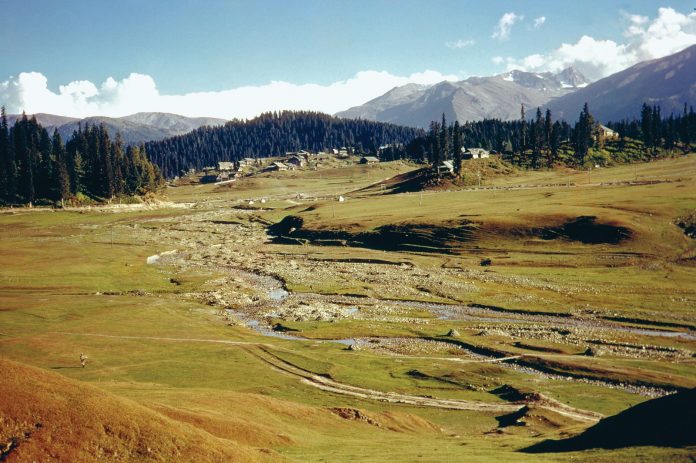This article is written by Mushtaq Dar, a student from School of Law, University of Kashmir. In this article, the author explains the Jammu and Kashmir State Lands (vesting of ownership to the occupants) Act, 2001.
Table of Contents
Brief Introduction
The Jammu and Kashmir State Lands (vesting of ownership to the occupants) Act was enacted in 2001, with the twin objective of generating resources for financing power projects and conferment of proprietary rights to the occupants of the state land. The Act has been enforced in the State w.e.f. 01-03-2002 vide SRO-94 dated 01-03- 2002 except in Ladakh and Kargil Districts.
What was mandated in the Act?
- The Roshni Act envisaged the transfer of ownership rights of state land to its occupants, subject to the payment of a cost, as determined by the government.
- Originally, it set 1990 as the cutoff for encroachment on state land.
- The government’s target was to earn Rs 25,000 crore by transferring 20 lakh kanals (equivalent to 25,6874.9732 acres) of state land to existing occupants against payment at its market value under this Act.
- The government said the revenue generated would be spent on commissioning hydroelectric power projects, hence the name “Roshni”.

Amendments
- In 2005 the government relaxed the cutoff year to 2004.
- Subsequently with new government coming to power the cutoff was relaxed further upto 31 Mar 2007.
- The government changed by subsequent amendments the original Act to a completely new thing.
- Cost of such land “at its market value under this Act” Substituted by “as determined under the Act and the rules made thereunder”
- The upper limit of 10 kanals of land that could vest in an illegal occupant by the earlier Act of 2001 was substituted by 100 kanals in 2007.
Allegations and Controversies- ‘Roshni’ to multi-billion land scam
The Jammu and Kashmir high court on 12 March 2020 pulled up the Union territory’s administration for alleged irregularities in land allotments under the erstwhile Roshni Act and said it will decide on March 18 whether to transfer the case to the Central Bureau of Investigation (CBI)
In 2014, a report by the Comptroller and Auditor General (CAG) estimated that against the targeted Rs 25,000 crore, only Rs 76 crore had been realised from the transfer of encroached land between 2007 and 2013, thus defeating the purpose of the legislation. The report blamed irregularities including arbitrary reduction in prices fixed by a standing committee, and said this was done to benefit politicians and affluent people.
The Comptroller and Auditor General of India’s report tabled in the State Legislature exposed Congress and National Conference — two principal mainstream political parties — as “institutional beneficiaries” of the Rs 25,000-crore Roshni scam, the biggest scandal in history of Jammu and Kashmir.
Investigations into the land transfers subsequently found that land in Gulmarg had been given over to ineligible beneficiaries. However several government officials illegally possessed and vested ownership of state land to occupants who did not satisfy criteria under the Roshni Act.
Repealed in 2018
November 2018 The State Administrative Council (SAC), under the chairmanship of Governor, Satya Pal Malik approved repeal of the Jammu and Kashmir State Lands (Vesting of Ownership to the Occupants) Act, 2001, (commonly known as Roshni scheme). because it had “failed to realise the desired objectives and there were also reports of misuse of some its provisions”.
What the repeal meant?
The SAC has ordered cancellation of all pending applications seeking vesting of ownership rights of state lands to their occupants. However, cases where such rights have already been transferred will hold.
Current Scenario- Latest developments in PIL
Ankur Sharma vs State Of J&K And Others
It is significant to highlight that the entire legislation was challenged before the Hon’ble High Court of J&K, in a Public Interest Litigation titled Ankur Sharma V/s State, wherein the High Court besides staying the proceedings under the said Act also directed that neither the occupants having been conferred upon the ownership rights shall sell these lands nor can raise constructions on such lands. The said PIL is pending before the High Court. The Court has also directed that no further transaction of any kind in respect of the property covered under the Roshni Act shall be affected till further orders of the High Court.
In para 4 of the said PIL, The petitioner has challenged the constitutionality of the said enactment and sought the following prayers:
(i) Declaring the Jammu and Kashmir State Lands (Vesting of Ownership to the Occupants) Act, 2001 and the rules framed thereunder i.e. The J&K State Lands (Vesting of Ownership to the Occupants) Rules, 2007 as unconstitutional/illegal being ultra- vires the Constitution of India and the Constitution of State of Jammu and Kashmir.
(ii) Commanding the respondents to disclose before this Hon’ble Court the names of the illegal occupants/beneficiaries who have been conferred the benefit of the aforementioned Act which is illegal/unconstitutional and all such orders of regularizations and consequential mutations attested under the impugned Act be declared void ab-initio/non est/illegal and the State Land so regularized be retrieved from the said illegal occupants/beneficiaries.
Section 5- Application for vesting or transfer of State land
The Section specifies the manner of application and the time limit within which it must be submitted to claim the benefits under the Act.
(1) Any occupant* of the State land may within the period specified [that he has applied or applies in the prescribed manner for transfer of vesting of such land within such period as the Government may, from time to time, specify]* apply in the prescribed form* to the territorial Tehsildar for having such land vested in or transferred to him under the provisions of this Act.
*Section 2 (e) defines “Occupant” as a person who is in actual physical possession of any State land on the commencement of the Jammu and Kashmir State Lands (Vesting of Ownership to the Occupants) (Amendment) Act, 2004, personally or through an authorized agent;
* [clause (b) of sub-section (1) of section 8]
*Prescribed form provided in The Jammu And Kashmir State Lands (Vesting of Ownership to the Occupants) Rules 2007 is as under; section 7. Procedure of application. – (1) An application in terms of sub-clause (b) of Sub section (1) of section 8 of the Act shall contain full particulars of the State land as per Form No.2. It shall be stamped with a court fee of Rs.10 and shall be verified in the manner prescribed for the verification of the pleadings in rule 15 of Order VI of the Code of Civil Procedure, Samvat 1977:
(2) The application under sub-section (1) shall be accompanied by:
(a) documentary proof to the effect that he is an occupant of a particular category of the State land in question;
(b) extract of Girdhawari;
(c) Shajra Kat (Tatma Shajra) of such land;
(Tatima, which literally translates into ‘Division of Plots’, is a kind of mutation deed. Tatima Shajra is a map prepared after division of plots, showing separate plots. Different states have different rules for preparation of the tatima.)
(d) a certificate by an officer not below the rank of Naib- Tehsildar that he has verified the Tatma-Shajra with reference to the position obtaining at the spot; and
(e) an affidavit to the effect,
(i) that he is an occupant of a particular category of the State land in question; and
(ii) that he shall neither be entitled to such land nor to refund of the cost paid in case any averment made in is found incorrect or false.
Section 6- Preliminary action on application
(1) On receipt of an application under section 5, the Tehsildar shall make an entry in a register duly numbered and also attest each such entry date-wise.
(2) The Tehsildar shall, after holding such enquiry, as he thinks fit, and after verifying the contents of the application, make a report to the District Collector of the area recommending that the application may be allowed for the whole or any part of the area of land to which it relates or that it may be rejected.
(3) The District Collector shall on receipt of a report under subsection (2) and after such further enquiry as he may deem fit [forward the application along with his report to the Committee] within two months from the date of its receipt in his office.
(4) The Committee shall pass appropriate orders for disposal of such land within two months from the date of receipt of application under sub-section (3) and also determine the price, to be deposited by the applicant for vesting of such State land [Provided that the Government may grant such rewards and incentives, and in such manner, as may be prescribed to the officers/officials showing excellent performance in administering the scheme under this Act.]
Section 7- Appeal
Any person aggrieved of an order passed by the *[Committee] relating to the price for vesting of free hold rights in favour of an occupant may file an appeal before the *[Government] who shall, as far as practicable, decide the same within 30 days of its filing. The decision of the *[Government] shall be final and binding.
*The words Committee” and “Government” substituted for “Administrative Department of the Government” and “Chief Minister” respectively by Act III of 2007, s. 6, w.e.f. 20-11-2006.
Conclusion
The Jammu and Kashmir State Lands (vesting of ownership to the occupants) Act 2001- (Roshni Act) with The Jammu and Kashmir state lands (vesting of ownership to the occupants) Rules, 2007. The government had changed by subsequent amendments the original Act to a completely whole different thing so as to forget about the very objective of generating the finance for power projects by introducing heavy discounts and rebates for vesting of ownership to the occupants of state land, which contributed in the failure to accomplish the very objectives desired for in the original Act, So the Act was repealed in 2018 as there were also reports of misuse of some of its provisions to benefit few affluent people.
The J&K State Lands (Vesting of Ownership to the Occupants) Act commonly known as Roshni Scheme had received the assent of the Governor on November 9, 2001 to give proprietary rights to the persons unauthorizedly holding the State land on payment of the cost equivalent to the prevailing market rate.
The procedural wrangles as also the apprehension that the eviction of the unauthorized occupants will lead to mass unrest formed the base line and the bedrock of the legislation.
Subsequently, the Government vide SRO-64 dated May 5, 2007 made the Rules for mapping of the State land, issuance of the notification, disposal of property left by the unauthorized occupants, the procedure for auction and eviction, determination of market value, vesting of ownership to the occupants of the structures raised over the State land, the fixation of price payable by different categories of occupants, the incentive and penalty for payment etc.
Latterly, the J&K State Lands (Vesting of Ownership to the Occupants) (Repeal and Savings) Act was assented to by the then Governor on December 7, 2018 mentioning that any proceedings pending before any authority under the Act of 2001 shall not be proceeded with and all pending proceedings shall stand abated. But no decision was taken in respect of the land already transferred to large number of people under the garb of Roshni Scheme.
However, after detailed examination of the Act of 2001 and going through various judgements of Supreme Court as well as different High Courts of the country, the J&K Law Commission headed by Justice (Retd) M K Hanjura has recommended retrieval of the land transferred in favour of the illegal beneficiaries under the garb of the Act of 2001.
LawSikho has created a telegram group for exchanging legal knowledge, referrals and various opportunities. You can click on this link and join:
 Serato DJ Crack 2025Serato DJ PRO Crack
Serato DJ Crack 2025Serato DJ PRO Crack










 Allow notifications
Allow notifications




U had a vast knowlege about the act..feeling good to see that..love u buddy rise and ahine